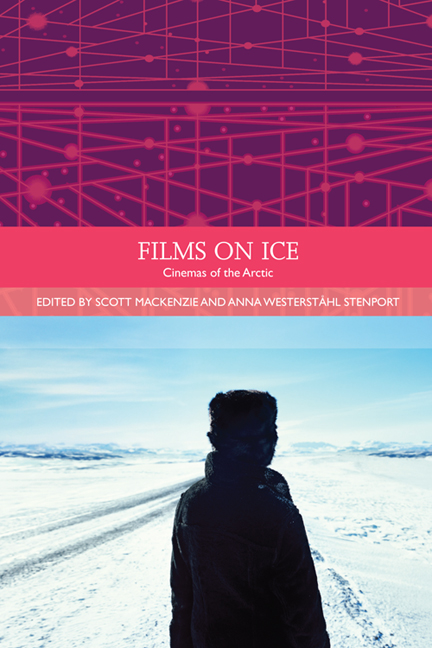Book contents
- Frontmatter
- Contents
- List of Illustrations
- Acknowledgements
- Traditions in World Cinema
- Introduction: What are Arctic Cinemas?
- PART I GLOBAL INDIGENEITY
- PART II HOLLYWOOD HEGEMONY
- PART III ETHNOGRAPHY AND THE DOCUMENTARY DILEMMA
- PART IV MYTHS AND MODES OF EXPLORATION
- 20 The Changing Polar Films: Silent Films from Arctic Exploration 1900–30
- 21 The Attractions of the North: Early Film Expeditions to the Exotic Snowscape
- 22 Frozen in Motion: Ethnographic Representation in Donald B. MacMillan's Arctic Films
- 23 ‘My Heart Beat for the Wilderness’: Isobel Wylie Hutchison, Jenny Gilbertson, Margaret Tait and Other Twentieth-Century Scottish Women Filmmakers
- 24 ‘Here will be a Garden-City’: Soviet Man on an Arctic Construction Site
- 25 Transcending the Sublime: Arctic Creolisation in the Works of Isaac Julien and John Akomfrah
- 26 DJ Spooky and Dziga Vertov: Experimental Cinema Meets Digital Art in Exploring the Polar Regions
- Notes on the Contributors
- Index
25 - Transcending the Sublime: Arctic Creolisation in the Works of Isaac Julien and John Akomfrah
from PART IV - MYTHS AND MODES OF EXPLORATION
Published online by Cambridge University Press: 05 September 2016
- Frontmatter
- Contents
- List of Illustrations
- Acknowledgements
- Traditions in World Cinema
- Introduction: What are Arctic Cinemas?
- PART I GLOBAL INDIGENEITY
- PART II HOLLYWOOD HEGEMONY
- PART III ETHNOGRAPHY AND THE DOCUMENTARY DILEMMA
- PART IV MYTHS AND MODES OF EXPLORATION
- 20 The Changing Polar Films: Silent Films from Arctic Exploration 1900–30
- 21 The Attractions of the North: Early Film Expeditions to the Exotic Snowscape
- 22 Frozen in Motion: Ethnographic Representation in Donald B. MacMillan's Arctic Films
- 23 ‘My Heart Beat for the Wilderness’: Isobel Wylie Hutchison, Jenny Gilbertson, Margaret Tait and Other Twentieth-Century Scottish Women Filmmakers
- 24 ‘Here will be a Garden-City’: Soviet Man on an Arctic Construction Site
- 25 Transcending the Sublime: Arctic Creolisation in the Works of Isaac Julien and John Akomfrah
- 26 DJ Spooky and Dziga Vertov: Experimental Cinema Meets Digital Art in Exploring the Polar Regions
- Notes on the Contributors
- Index
Summary
Through Western culture's long-distance love affair with its northernmost regions, the Arctic simulacrum has become synonymous with vastness, whiteness, tranquillity and, especially, the sublime: the ultimate awe-inspiring no-man's land. The connection between the Arctic and the sublime is a powerful and lasting one, even if increasingly questioned in the past decades. Today, connotations of spaces previously ‘seen as literally and symbolically white’ are no longer the ‘site of a privileged white masculinity’ as the myth of no-man's land is rapidly being creolised (Sandhu 2010; Bloom 2010: 31). Indigenous peoples now compete with neo-imperial interests in ownership of their homelands, objecting to the Anglophone concepts of ‘wilderness’ and ‘landscape’ dominating the discourse on the Nordic regions because such ‘approaches erode the appreciation of distinctively Northern and Indigenous aspects of land and life’ (Lehtinen 2012: 108). Indeed, the Arctic region itself is increasingly seen as needing protection rather than being regarded as the awe-inspiring challenge it once was.
While artists were instrumental in creating the simulacrum of the Arctic and maintaining its sublimity, they have been equally influential in changing our understanding of the region via a range of media, as can be seen, for example, from artistic involvement in David Buckland's massive Cape Farewell project; Magali Daniaux and C édric Pigot's array of digital works; Nele Azevedo's travelling installations of her Army of Melting Men; or DJ Spooky's multidisciplinary project Terra Nova: Sinfonia Antarctica, discussed at length by Daria Shembel in Chapter 26 of this volume.
This chapter focuses on two London-based visual artists, the filmmaker John Akomfrah and the conceptual film artist Isaac Julien. Both artists explore and manipulate Arctic imagery through creolisation of the landscape, thus actively challenging Western nature ideology and (neo-)imperial claims of ownership albeit through different means and with different agenda. Akomfrah relies on the medium of film and the framework of the documentary which he then pushes to the extreme, leaving the audience to decipher meaning whichever way they can, while Julien actively rejects the rigid screen-viewer axis by screening his fragmentally narrated film installation on multiple panels, frequently accompanied by a selection of stills (Groner 2006: 15).
- Type
- Chapter
- Information
- Films on IceCinemas of the Arctic, pp. 325 - 334Publisher: Edinburgh University PressPrint publication year: 2014



